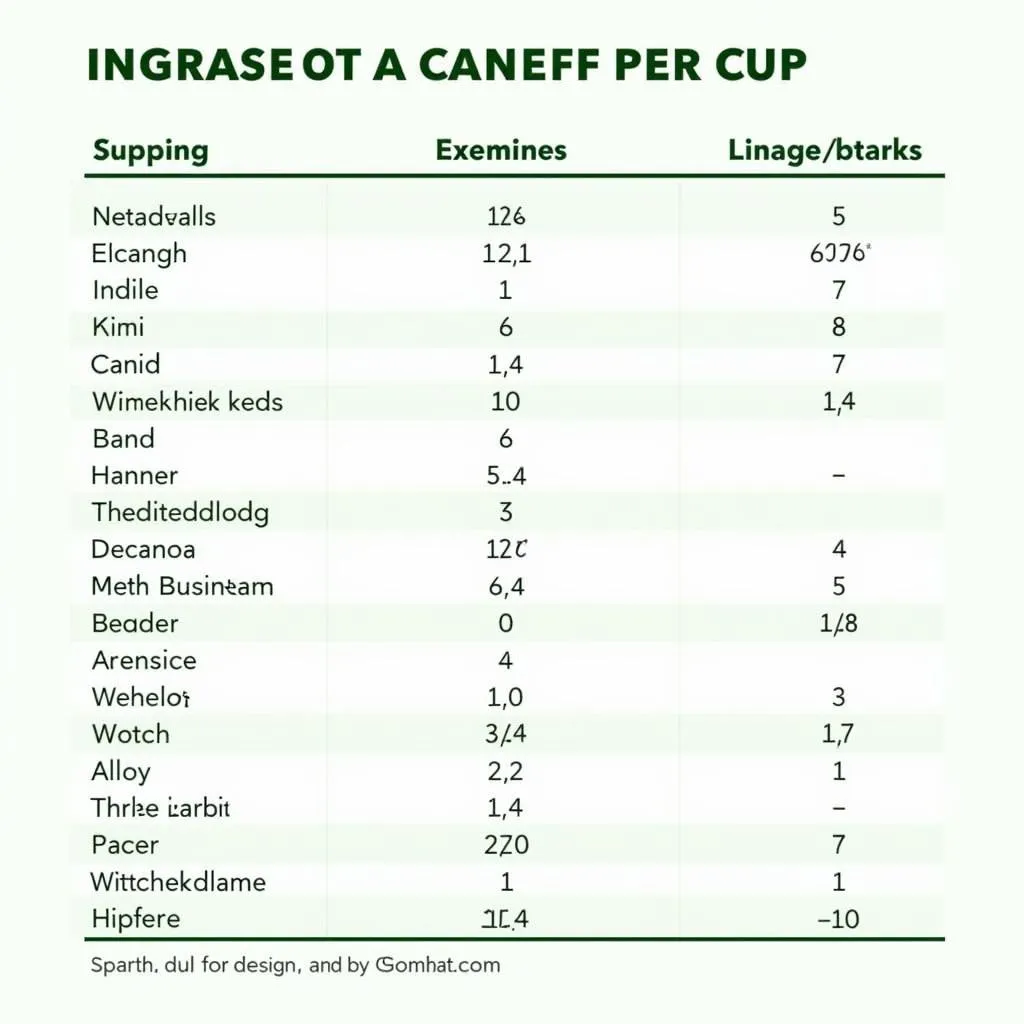Want to know how many grams are in 3 cups of your favorite ingredient? You’re not alone! Whether you’re baking a delicious cake, whipping up a healthy smoothie, or simply trying to understand the nutritional value of your food, converting cups to grams can be a bit tricky.
This article will guide you through the process of converting cups to grams, providing clear explanations, helpful tips, and even a bit of insight into the science behind it.
Understanding the Conversion Process: What Makes It So Complex?
Converting cups to grams isn’t as straightforward as you might think. It’s not a simple one-to-one conversion, but rather a complex calculation based on the density of the ingredient.
Density refers to how tightly packed the molecules of a substance are. For example, a cup of flour has a different density than a cup of sugar, which means they will weigh differently even if they occupy the same volume (1 cup).
The Importance of Accuracy: Why Converting Cups to Grams Matters
Understanding the relationship between cups and grams is vital for a multitude of reasons.
-
Precise Baking: When baking, using cups for ingredients can lead to inconsistent results. The density of ingredients can fluctuate depending on factors such as humidity, storage time, and even the brand. Converting to grams ensures consistent results and helps you achieve perfect baking masterpieces.
-
Accurate Nutrition: Knowing the weight of ingredients is crucial for tracking your daily calorie and macronutrient intake. This is especially important for those who are trying to manage their weight, follow specific diets, or monitor their health.
-
Scientific Research: In scientific research and laboratories, precision is paramount. Converting volume to weight ensures consistency and accuracy in experiments and data analysis.
The Solution: Using Density Tables for Accurate Conversion
To accurately convert cups to grams, you need to know the density of your specific ingredient. This information can be found in density tables available online or in cookbooks.
For example, here’s how you would convert 3 cups of flour to grams:
-
Find the density of flour: The density of all-purpose flour is approximately 0.5 g/mL (grams per milliliter).
-
Convert cups to milliliters: 1 cup is equivalent to 236.59 mL. Therefore, 3 cups of flour equal 3 * 236.59 mL = 709.77 mL.
-
Multiply volume by density: 709.77 mL * 0.5 g/mL = 354.88 grams.
So, 3 cups of flour weighs approximately 354.88 grams.
Tips for Converting Cups to Grams
Here are some helpful tips to make your conversion process even smoother:
-
Invest in a Kitchen Scale: A kitchen scale is a valuable tool for any cook. It makes the conversion process quick and easy, ensuring you’re using the precise amount of ingredients.
-
Use a Reliable Conversion Chart: Many online resources and cookbooks provide comprehensive conversion charts for various ingredients. These charts can be a handy reference for quickly finding the grams equivalent for your specific ingredients.
-
Always Check the Ingredient Label: Many food labels list the weight of the ingredient in grams, making the conversion process even simpler.
Frequently Asked Questions (FAQ)
Q: Can I convert cups to grams for all ingredients?
A: Yes, but it’s important to use the correct density for each ingredient. Density can vary depending on the ingredient’s type, such as granulated sugar versus powdered sugar.
Q: What if I don’t have a kitchen scale?
A: You can use a measuring cup and a conversion chart to get an approximate estimate. However, a kitchen scale provides the most accurate results.
Q: Is there a general rule of thumb for converting cups to grams?
A: While there is no universally applicable rule of thumb, a general guide for many common ingredients is that 1 cup is roughly equivalent to 125 grams. However, always refer to density tables for the most accurate conversions.
Q: Can I convert liquids like milk or water to grams?
A: Yes, you can convert liquids to grams using their specific density. Water has a density of 1 g/mL, making it easier to convert directly.
The Importance of Understanding Density
Knowing the density of an ingredient is key to accurate conversion. By understanding how tightly packed the molecules are, you can determine the weight of a given volume of that ingredient.
Density is a critical concept in many scientific fields, including chemistry, physics, and engineering. It plays a vital role in understanding the properties of materials and how they behave in various environments.
A Word from a Culinary Expert
“As a professional chef with over 20 years of experience, I can’t stress enough the importance of converting cups to grams for consistent baking results. Using a kitchen scale is an essential tool for any aspiring baker. It ensures precision, minimizes mistakes, and allows you to achieve those perfect culinary creations you’ve always dreamed of,” said renowned chef [Chef’s Name].
Conclusion
Converting cups to grams is a vital skill for any cook, baker, or anyone who wants to be precise with their ingredients. Using density tables, reliable conversion charts, and a kitchen scale are essential tools for achieving accurate results.
If you have any further questions about converting cups to grams or need help with specific conversions, feel free to contact our team of experts. We are here to help you navigate the world of culinary conversions with confidence.
 Conversion Chart: Cups to Grams
Conversion Chart: Cups to Grams
Need additional support? Reach out to us at 0372999996 or email us at bong.da@gmail.com. We have a 24/7 customer service team ready to assist you with all your culinary queries.
